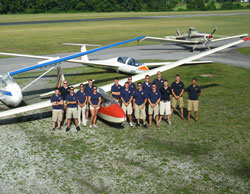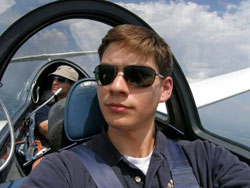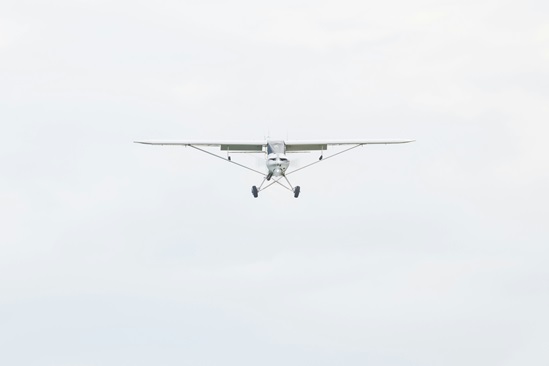 The U.S. Naval Academy’s Summer Training Soaring Program introduced 150 midshipmen to flying this summer using gliders at the Mid-Atlantic Soaring Center Airport.
The U.S. Naval Academy’s Summer Training Soaring Program introduced 150 midshipmen to flying this summer using gliders at the Mid-Atlantic Soaring Center Airport.
Before they embrace the roar of a jet engine or helicopter, 150 Naval Academy midshipmen had a chance this summer to get a feel for the controls in the whisper of engineless flight.
The U.S. Naval Academy’s Summer Training Soaring Program began this year as a way to introduce interested midshipmen at the school to flying before they commit to a Naval career path. The students had a chance to practice stick-and-rudder skills without the costly turn of the Hobbs meter and to learn the principles of flight before heading to Pensacola, Fla., for intensive training. After a successful first summer, leaders of the program are working to garner support and expand the offering for next year.
Spreading the word
Cmdr. Brian Randall, the summer program’s chief glider and ground school instructor, stood by the runway at Mid Atlantic Soaring Center Airport in Fairfield, Pa., on a cool October afternoon, waiting for two officers who were making the nearly two-hour drive from Annapolis, Md., to have a taste of the program. Randall had offered to take aviators from the academy on a glider flight to show them what a new class of midshipmen could experience in the summer program.
“This is a great way to expose folks to aviation,” Randall said. Soaring gives the midshipmen a chance to focus on the basic stick-and-rudder skills that will form the foundation of their training. Inside the cockpit, there is no engine roar, no headsets, no complex avionics. The students can focus on mastering the aerodynamic principles and weather patterns that keep them aloft without an engine.
Randall and many other Naval aviators did not have an opportunity to get flight training in the Navy before making the seven-year commitment to Naval aviation. The summer program, run by the extra-curricular Naval Academy Fixed-Wing Training Squadron (VT-NA) and hosted by the Mid-Atlantic Soaring Association (M-ASA), gives midshipmen an opportunity to find out early if aviation is right for them—and to better their chances of success in primary flight training. Randall is promoting the program to officers at the Naval Academy and hopes to expand it as an inexpensive avenue to provide students with relevant training.
Lt. Cmdr. Lisa Berberich, one of the two Naval aviators who arrived that day, said she had no flight training before the first week of primary training—an intense introduction to flight that can be overwhelming for student Naval aviators with no previous training. Since Berberich went through the program, the Navy has added introductory flight screening, an opportunity for midshipmen who have put in requests to be pilots to train in general aviation aircraft during their last semester of college. However, no curriculum exists to expose the students to flying before they commit to aviation, even though more than 40 percent of the academy’s graduating class are designated for Naval aviation service each year. Berberich came to see what such a program is like—and to experience soaring.
 Training in a sailplane, students can focus on mastering the aerodynamic principles and weather patterns that keep them aloft without an engine. Shown here, midshipman Scott M. Keelan (right) trains with Cmdr. Brian Randall (left), the summer program’s chief glider and ground school instructor.
Training in a sailplane, students can focus on mastering the aerodynamic principles and weather patterns that keep them aloft without an engine. Shown here, midshipman Scott M. Keelan (right) trains with Cmdr. Brian Randall (left), the summer program’s chief glider and ground school instructor.
Berberich, a helicopter pilot, said she had not flown fixed-wing aircraft since 1999. She climbed into the Grob 103, seated in front of Randall, and the tow pilot taxied onto the runway. Tethered to the Piper Pawnee towplane, the glider climbed to release altitude and let go. In the hush of the cockpit, Randall and Berberich went searching for lift.
The flight took the Grob to the north, west over Liberty Mountain, and around to the east. Riding a wave cloud, Berberich felt the unfamiliar (to a helicopter pilot) sensation of negative Gs. She decided she would like to come back sometime for more.
The experience has a way of catching on. After participating in VT-NA gliding as a tow pilot, Ensign Steve Dorman got his private glider certificate. Lt. Pat Anderson, the other aviator who came to Mid Atlantic Soaring Center Airport that afternoon, tried gliding during the summer and came back for more. He worked on administration, billeting, and scheduling for the program and said midshipmen have responded favorably to it. “They all really enjoy it. It’s a unique experience for them,” he said.
Determined to fly
The academy’s soaring program grew out of the desire and initiative of a group of midshipmen who wanted to get flying experience and were willing to work for it. VT-NA, which is midshipmen-run and supported by active and retired Naval aviators, provides opportunities for training on the ground but has not had a flight component since its powered flight portion was disbanded because of the cost. A group of students began traveling to the Fairfield gliderport on weekends during the school year when there was no home football game to train through M-ASA, a soaring club based at the field.
“Before the summer program, everybody was doing this out of pocket,” Randall said. For college students on a budget, soaring was a more affordable alternative to powered flight. “A lot of them can’t afford to go to an FBO and pay $150 an hour.”
VT-NA worked out an arrangement in which the soaring association waived the cost of the aircraft and instructor for the midshipmen, leaving only the cost of fuel for the towplane—about $35, Randall said. The midshipmen also could work to offset the expense. They worked concessions at football games to raise money and did odd jobs around the airport—filling cracks in the runway, mowing the lawn—to earn “youth credits” toward flying time. When they were training in Fairfield on two consecutive days, they camped on the grounds.
As more midshipmen became interested in VT-NA’s soaring excursions, aviation leaders at the Naval Academy worked with VT-NA and M-ASA to create the summer program. The program provided initial flight exposure to 150 students and included more than 500 training sorties and 216 hours of classroom instruction. Fifteen participants took their FAA private pilot written exam after the course.
Randall hopes to build on the success of this summer to expand the program for next year. He said the academy commandant has decided to augment the budget, money which he plans to use to train instructors for next year. Just three instructors—Randall, Ensign Sean Noronha, and M-ASA’s George Simms—handled all of the flights for 2009.
The program also expects additions to the fleet. Midshipmen have so far been training in three M-ASA sailplanes, but VT-NA is planning to receive trainer aircraft from the Air Force. The Air Force Academy maintains a large fleet of aircraft for training and has three flight squadrons for its students: powered aircraft, sailplanes, and parachutes. With a new paint job, the surplus sailplanes will serve the Naval Academy.
“We have a long way to go still,” Randall said. But he hopes to grow the program so that the Naval Academy can field soaring teams at competitions. “Eventually, someday we would like to compete against Air Force.”


